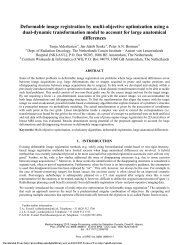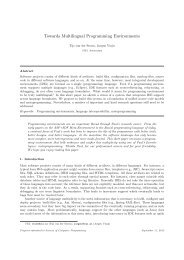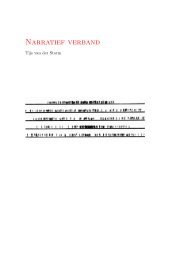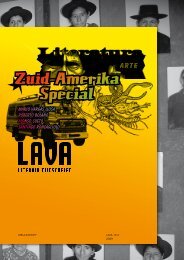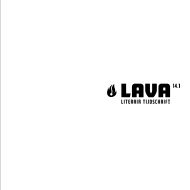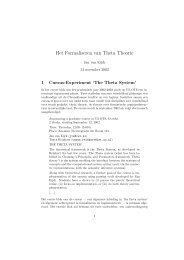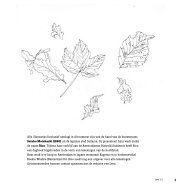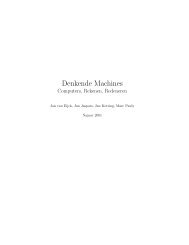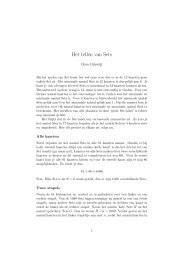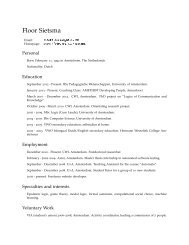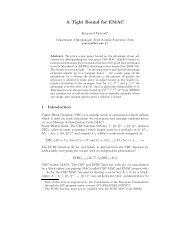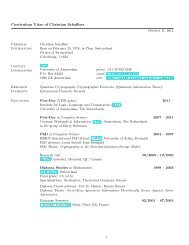Object-Oriented Databases Need for Complex Data Types - CWI
Object-Oriented Databases Need for Complex Data Types - CWI
Object-Oriented Databases Need for Complex Data Types - CWI
You also want an ePaper? Increase the reach of your titles
YUMPU automatically turns print PDFs into web optimized ePapers that Google loves.
<strong>Data</strong>base System Concepts<br />
<strong>Data</strong>base System Concepts<br />
Chapter 8: <strong>Object</strong>-<strong>Oriented</strong> <strong>Object</strong> <strong>Oriented</strong> <strong><strong>Data</strong>bases</strong><br />
<strong>Need</strong> <strong>for</strong> <strong>Complex</strong> <strong>Data</strong> <strong>Types</strong><br />
The <strong>Object</strong>-<strong>Oriented</strong> <strong>Data</strong> Model<br />
<strong>Object</strong>-<strong>Oriented</strong> Languages<br />
Persistent Programming Languages<br />
Persistent C++ Systems<br />
8.1<br />
<strong>Need</strong> <strong>for</strong> <strong>Complex</strong> <strong>Data</strong> <strong>Types</strong><br />
8.2<br />
©Silberschatz, Korth and Sudarshan<br />
Traditional database applications in data processing had<br />
conceptually simple data types<br />
Relatively few data types, first normal <strong>for</strong>m holds<br />
<strong>Complex</strong> data types have grown more important in recent years<br />
E.g. Addresses can be viewed as a<br />
Single string, or<br />
Separate attributes <strong>for</strong> each part, or<br />
Composite attributes (which are not in first normal <strong>for</strong>m)<br />
E.g. it is often convenient to store multivalued attributes as-is,<br />
without creating a separate relation to store the values in first<br />
normal <strong>for</strong>m<br />
Applications<br />
computer-aided design, computer-aided software engineering<br />
multimedia and image databases, and document/hypertext<br />
databases.<br />
©Silberschatz, Korth and Sudarshan<br />
1
<strong>Data</strong>base System Concepts<br />
<strong>Object</strong>-<strong>Oriented</strong> <strong>Object</strong> <strong>Oriented</strong> <strong>Data</strong> Model<br />
Loosely speaking, an object corresponds to an entity in the E-<br />
R model.<br />
The object-oriented paradigm is based on encapsulating code<br />
and data related to an object into single unit.<br />
The object-oriented data model is a logical data model (like<br />
the E-R model).<br />
Adaptation of the object-oriented programming paradigm (e.g.,<br />
Smalltalk, C++) to database systems.<br />
<strong>Data</strong>base System Concepts<br />
8.3<br />
<strong>Object</strong> Structure<br />
An object has associated with it:<br />
8.4<br />
©Silberschatz, Korth and Sudarshan<br />
A set of variables that contain the data <strong>for</strong> the object. The value of<br />
each variable is itself an object.<br />
A set of messages to which the object responds; each message may<br />
have zero, one, or more parameters.<br />
A set of methods, each of which is a body of code to implement a<br />
message; a method returns a value as the response to the message<br />
The physical representation of data is visible only to the<br />
implementor of the object<br />
Messages and responses provide the only external interface to an<br />
object.<br />
The term message does not necessarily imply physical message<br />
passing. Messages can be implemented as procedure<br />
invocations.<br />
©Silberschatz, Korth and Sudarshan<br />
2
<strong>Data</strong>base System Concepts<br />
Messages and Methods<br />
Methods are programs written in general-purpose language<br />
with the following features<br />
only variables in the object itself may be referenced directly<br />
data in other objects are referenced only by sending messages.<br />
Methods can be read-only or update methods<br />
Read-only methods do not change the value of the object<br />
Strictly speaking, every attribute of an entity must be<br />
represented by a variable and two methods, one to read and<br />
the other to update the attribute<br />
e.g., the attribute address is represented by a variable address<br />
and two messages get-address and set-address.<br />
<strong>Data</strong>base System Concepts<br />
For convenience, many object-oriented data models permit direct<br />
access to variables of other objects.<br />
8.5<br />
<strong>Object</strong> Classes<br />
8.6<br />
©Silberschatz, Korth and Sudarshan<br />
Similar objects are grouped into a class; each such object is<br />
called an instance of its class<br />
All objects in a class have the same<br />
Variables, with the same types<br />
message interface<br />
methods<br />
The may differ in the values assigned to variables<br />
Example: Group objects <strong>for</strong> people into a person class<br />
Classes are analogous to entity sets in the E-R model<br />
©Silberschatz, Korth and Sudarshan<br />
3
<strong>Data</strong>base System Concepts<br />
Class Definition Example<br />
class employee {<br />
/*Variables */<br />
string name;<br />
string address;<br />
date start-date;<br />
int salary;<br />
/* Messages */<br />
int annual-salary();<br />
string get-name();<br />
string get-address();<br />
int set-address(string new-address);<br />
int employment-length();<br />
};<br />
Methods to read and set the other variables are also needed with<br />
strict encapsulation<br />
Methods are defined separately<br />
E.g. int employment-length() { return today() – start-date;}<br />
int set-address(string new-address) { address = new-address;}<br />
<strong>Data</strong>base System Concepts<br />
8.7<br />
Inheritance<br />
8.8<br />
©Silberschatz, Korth and Sudarshan<br />
E.g., class of bank customers is similar to class of bank<br />
employees, although there are differences<br />
both share some variables and messages, e.g., name and address.<br />
But there are variables and messages specific to each class e.g.,<br />
salary <strong>for</strong> employees and credit-rating <strong>for</strong> customers.<br />
Every employee is a person; thus employee is a specialization of<br />
person<br />
Similarly, customer is a specialization of person.<br />
Create classes person, employee and customer<br />
variables/messages applicable to all persons associated with class<br />
person.<br />
variables/messages specific to employees associated with class<br />
employee; similarly <strong>for</strong> customer<br />
©Silberschatz, Korth and Sudarshan<br />
4
<strong>Data</strong>base System Concepts<br />
<strong>Data</strong>base System Concepts<br />
Inheritance (Cont.)<br />
Place classes into a specialization/IS-A hierarchy<br />
variables/messages belonging to class person are<br />
inherited by class employee as well as customer<br />
Result is a class hierarchy<br />
Note analogy with ISA Hierarchy in the E-R model<br />
.<br />
8.9<br />
Class Hierarchy Definition<br />
class person{<br />
string name;<br />
string address:<br />
};<br />
class customer isa person {<br />
int credit-rating;<br />
};<br />
class employee isa person {<br />
date start-date;<br />
int salary;<br />
};<br />
class officer isa employee {<br />
int office-number,<br />
int expense-account-number,<br />
};<br />
8.10<br />
©Silberschatz, Korth and Sudarshan<br />
©Silberschatz, Korth and Sudarshan<br />
5
<strong>Data</strong>base System Concepts<br />
Class Hierarchy Example (Cont.)<br />
Full variable list <strong>for</strong> objects in the class officer:<br />
office-number, expense-account-number: defined locally<br />
start-date, salary: inherited from employee<br />
name, address: inherited from person<br />
Methods inherited similar to variables.<br />
Substitutability — any method of a class, say person, can be invoked<br />
equally well with any object belonging to any subclass, such as<br />
subclass officer of person.<br />
Class extent: set of all objects in the class. Two options:<br />
<strong>Data</strong>base System Concepts<br />
1. Class extent of employee includes all officer, teller and secretary objects.<br />
2. Class extent of employee includes only employee objects that are not in a<br />
subclass such as officer, teller, or secretary<br />
This is the usual choice in OO systems<br />
Can access extents of subclasses to find all objects of<br />
subtypes of employee<br />
8.11<br />
Example of Multiple Inheritance<br />
Class DAG <strong>for</strong> banking example.<br />
8.12<br />
©Silberschatz, Korth and Sudarshan<br />
©Silberschatz, Korth and Sudarshan<br />
6
<strong>Data</strong>base System Concepts<br />
Multiple Inheritance<br />
With multiple inheritance a class may have more than one superclass.<br />
The class/subclass relationship is represented by a directed acyclic graph<br />
(DAG)<br />
Particularly useful when objects can be classified in more than one way,<br />
which are independent of each other<br />
E.g. temporary/permanent is independent of Officer/secretary/teller<br />
Create a subclass <strong>for</strong> each combination of subclasses<br />
– <strong>Need</strong> not create subclasses <strong>for</strong> combinations that are not possible in<br />
the database being modeled<br />
A class inherits variables and methods from all its superclasses<br />
There is potential <strong>for</strong> ambiguity when a variable/message N with the<br />
same name is inherited from two superclasses A and B<br />
No problem if the variable/message is defined in a shared superclass<br />
Otherwise, do one of the following<br />
flag as an error,<br />
rename variables (A.N and B.N)<br />
choose one.<br />
<strong>Data</strong>base System Concepts<br />
8.13<br />
8.14<br />
©Silberschatz, Korth and Sudarshan<br />
More Examples of Multiple Inheritance<br />
Conceptually, an object can belong to each of several<br />
subclasses<br />
A person can play the roles of student, a teacher or footballPlayer,<br />
or any combination of the three<br />
E.g., student teaching assistant who also play football<br />
Can use multiple inheritance to model “roles” of an object<br />
That is, allow an object to take on any one or more of a set of types<br />
But many systems insist an object should have a most-specific<br />
class<br />
That is, there must be one class that an object belongs to which is<br />
a subclass of all other classes that the object belongs to<br />
Create subclasses such as student-teacher and<br />
student-teacher-footballPlayer <strong>for</strong> each combination<br />
When many combinations are possible, creating<br />
subclasses <strong>for</strong> each combination can become cumbersome<br />
©Silberschatz, Korth and Sudarshan<br />
7
<strong>Data</strong>base System Concepts<br />
<strong>Object</strong> Identity<br />
An object retains its identity even if some or all of the values<br />
of variables or definitions of methods change over time.<br />
<strong>Object</strong> identity is a stronger notion of identity than in<br />
programming languages or data models not based on object<br />
orientation.<br />
Value – data value; e.g. primary key value used in relational<br />
systems.<br />
Name – supplied by user; used <strong>for</strong> variables in procedures.<br />
<strong>Data</strong>base System Concepts<br />
Built-in – identity built into data model or programming<br />
language.<br />
no user-supplied identifier is required.<br />
Is the <strong>for</strong>m of identity used in object-oriented systems.<br />
8.15<br />
<strong>Object</strong> Identifiers<br />
<strong>Object</strong> identifiers used to uniquely identify objects<br />
<strong>Object</strong> identifiers are unique:<br />
no two objects have the same identifier<br />
each object has only one object identifier<br />
E.g., the spouse field of a person object may be an identifier of<br />
another person object.<br />
can be stored as a field of an object, to refer to another object.<br />
Can be<br />
system generated (created by database) or<br />
external (such as social-security number)<br />
System generated identifiers:<br />
8.16<br />
©Silberschatz, Korth and Sudarshan<br />
Are easier to use, but cannot be used across database systems<br />
May be redundant if unique identifier already exists<br />
©Silberschatz, Korth and Sudarshan<br />
8
<strong>Data</strong>base System Concepts<br />
<strong>Object</strong> Containment<br />
Each component in a design may contain other components<br />
Can be modeled as containment of objects. <strong>Object</strong>s containing;<br />
other objects are called composite objects.<br />
Multiple levels of containment create a containment hierarchy<br />
links interpreted as is-part-of, not is-a.<br />
Allows data to be viewed at different granularities by different<br />
users.<br />
<strong>Data</strong>base System Concepts<br />
8.17<br />
<strong>Object</strong>-<strong>Oriented</strong> <strong>Object</strong> <strong>Oriented</strong> Languages<br />
<strong>Object</strong>-oriented concepts can be used in different ways<br />
<strong>Object</strong>-orientation can be used as a design tool, and be<br />
encoded into, <strong>for</strong> example, a relational database<br />
analogous to modeling data with E-R diagram and then<br />
converting to a set of relations)<br />
The concepts of object orientation can be incorporated into a<br />
programming language that is used to manipulate the<br />
database.<br />
<strong>Object</strong>-relational systems – add complex types and<br />
object-orientation to relational language.<br />
Persistent programming languages – extend objectoriented<br />
programming language to deal with databases<br />
by adding concepts such as persistence and collections.<br />
8.18<br />
©Silberschatz, Korth and Sudarshan<br />
©Silberschatz, Korth and Sudarshan<br />
9
<strong>Data</strong>base System Concepts<br />
Persistent Programming Languages<br />
Persistent Programming languages allow objects to be created<br />
and stored in a database, and used directly from a programming<br />
language<br />
allow data to be manipulated directly from the programming language<br />
No need to go through SQL.<br />
No need <strong>for</strong> explicit <strong>for</strong>mat (type) changes<br />
<strong>for</strong>mat changes are carried out transparently by system<br />
Without a persistent programming language, <strong>for</strong>mat changes<br />
becomes a burden on the programmer<br />
– More code to be written<br />
– More chance of bugs<br />
allow objects to be manipulated in-memory<br />
<strong>Data</strong>base System Concepts<br />
no need to explicitly load from or store to the database<br />
– Saved code, and saved overhead of loading/storing large<br />
amounts of data<br />
8.19<br />
8.20<br />
©Silberschatz, Korth and Sudarshan<br />
Persistent Prog. Prog.<br />
Languages (Cont.)<br />
Drawbacks of persistent programming languages<br />
Due to power of most programming languages, it is easy to make<br />
programming errors that damage the database.<br />
<strong>Complex</strong>ity of languages makes automatic high-level optimization<br />
more difficult.<br />
Do not support declarative querying as well as relational databases<br />
©Silberschatz, Korth and Sudarshan<br />
10
<strong>Data</strong>base System Concepts<br />
<strong>Data</strong>base System Concepts<br />
Persistence of <strong>Object</strong>s<br />
Approaches to make transient objects persistent include<br />
establishing<br />
Persistence by Class – declare all objects of a class to be<br />
persistent; simple but inflexible.<br />
Persistence by Creation – extend the syntax <strong>for</strong> creating objects to<br />
specify that that an object is persistent.<br />
Persistence by Marking – an object that is to persist beyond<br />
program execution is marked as persistent be<strong>for</strong>e program<br />
termination.<br />
Persistence by Reachability - declare (root) persistent objects;<br />
objects are persistent if they are referred to (directly or indirectly)<br />
from a root object.<br />
Easier <strong>for</strong> programmer, but more overhead <strong>for</strong> database system<br />
Similar to garbage collection used e.g. in Java, which<br />
also per<strong>for</strong>ms reachability tests<br />
8.21<br />
<strong>Object</strong> Identity and Pointers<br />
8.22<br />
©Silberschatz, Korth and Sudarshan<br />
A persistent object is assigned a persistent object identifier.<br />
Degrees of permanence of identity:<br />
Intraprocedure – identity persists only during the executions of a<br />
single procedure<br />
Intraprogram – identity persists only during execution of a single<br />
program or query.<br />
Interprogram – identity persists from one program execution to<br />
another, but may change if the storage organization is changed<br />
Persistent – identity persists throughout program executions and<br />
structural reorganizations of data; required <strong>for</strong> object-oriented<br />
systems.<br />
©Silberschatz, Korth and Sudarshan<br />
11
<strong>Data</strong>base System Concepts<br />
<strong>Data</strong>base System Concepts<br />
<strong>Object</strong> Identity and Pointers (Cont.)<br />
In O-O languages such as C++, an object identifier is<br />
actually an in-memory pointer.<br />
Persistent pointer – persists beyond program execution<br />
can be thought of as a pointer into the database<br />
E.g. specify file identifier and offset into the file<br />
Problems due to database reorganization have to be dealt<br />
with by keeping <strong>for</strong>warding pointers<br />
8.23<br />
8.24<br />
©Silberschatz, Korth and Sudarshan<br />
Storage and Access of Persistent <strong>Object</strong>s<br />
How to find objects in the database:<br />
Name objects (as you would name files)<br />
Cannot scale to large number of objects.<br />
Typically given only to class extents and other collections of<br />
objects, but not objects.<br />
Expose object identifiers or persistent pointers to the objects<br />
Can be stored externally.<br />
All objects have object identifiers.<br />
Store collections of objects, and allow programs to iterate<br />
over the collections to find required objects<br />
Model collections of objects as collection types<br />
Class extent - the collection of all objects belonging to the<br />
class; usually maintained <strong>for</strong> all classes that can have persistent<br />
objects.<br />
©Silberschatz, Korth and Sudarshan<br />
12
<strong>Data</strong>base System Concepts<br />
Persistent C++ Systems<br />
C++ language allows support <strong>for</strong> persistence to be added without<br />
changing the language<br />
Declare a class called Persistent_<strong>Object</strong> with attributes and methods<br />
to support persistence<br />
Overloading – ability to redefine standard function names and<br />
operators (i.e., +, –, the pointer deference operator –>) when applied<br />
to new types<br />
Template classes help to build a type-safe type system supporting<br />
collections and persistent types.<br />
Providing persistence without extending the C++ language is<br />
relatively easy to implement<br />
but more difficult to use<br />
Persistent C++ systems that add features to the C++ language<br />
have been built, as also systems that avoid changing the<br />
language<br />
<strong>Data</strong>base System Concepts<br />
8.25<br />
8.26<br />
©Silberschatz, Korth and Sudarshan<br />
ODMG C++ <strong>Object</strong> Definition Language<br />
The <strong>Object</strong> <strong>Data</strong>base Management Group is an industry<br />
consortium aimed at standardizing object-oriented databases<br />
in particular persistent programming languages<br />
Includes standards <strong>for</strong> C++, Smalltalk and Java<br />
ODMG-93<br />
ODMG-2.0 and 3.0 (which is 2.0 plus extensions to Java)<br />
Our description based on ODMG-2.0<br />
ODMG C++ standard avoids changes to the C++ language<br />
provides functionality via template classes and class libraries<br />
©Silberschatz, Korth and Sudarshan<br />
13
<strong>Data</strong>base System Concepts<br />
<strong>Data</strong>base System Concepts<br />
ODMG <strong>Types</strong><br />
Template class d_Ref used to specify references<br />
(persistent pointers)<br />
Template class d_Set used to define sets of objects.<br />
Methods include insert_element(e) and delete_element(e)<br />
Other collection classes such as d_Bag (set with duplicates<br />
allowed), d_List and d_Varray (variable length array) also<br />
provided.<br />
d_ version of many standard types provided, e.g. d_Long and<br />
d_string<br />
Interpretation of these types is plat<strong>for</strong>m independent<br />
Dynamically allocated data (e.g. <strong>for</strong> d_string) allocated in the<br />
database, not in main memory<br />
8.27<br />
ODMG C++ ODL: Example<br />
class Branch : public d_<strong>Object</strong> {<br />
….<br />
}<br />
class Person : public d_<strong>Object</strong> {<br />
public:<br />
d_String name; // should not use String!<br />
d_String address;<br />
};<br />
class Account : public d_<strong>Object</strong> {<br />
private:<br />
d_Long balance;<br />
public:<br />
d_Long number;<br />
d_Set owners;<br />
int find_balance();<br />
int update_balance(int delta);<br />
};<br />
8.28<br />
©Silberschatz, Korth and Sudarshan<br />
©Silberschatz, Korth and Sudarshan<br />
14
<strong>Data</strong>base System Concepts<br />
ODMG C++ ODL: Example (Cont.)<br />
class Customer : public Person {<br />
public:<br />
d_Date member_from;<br />
d_Long customer_id;<br />
d_Ref home_branch;<br />
d_Set accounts; };<br />
<strong>Data</strong>base System Concepts<br />
8.29<br />
Implementing Relationships<br />
8.30<br />
©Silberschatz, Korth and Sudarshan<br />
Relationships between classes implemented by references<br />
Special reference types en<strong>for</strong>ces integrity by adding/removing<br />
inverse links.<br />
Type d_Rel_Ref is a reference to Class, where<br />
attribute InvRef of Class is the inverse reference.<br />
Similarly, d_Rel_Set is used <strong>for</strong> a set of references<br />
Assignment method (=) of class d_Rel_Ref is overloaded<br />
Uses type definition to automatically find and update the inverse<br />
link<br />
Frees programmer from task of updating inverse links<br />
Eliminates possibility of inconsistent links<br />
Similarly, insert_element() and delete_element() methods of<br />
d_Rel_Set use type definition to find and update the inverse link<br />
automatically<br />
©Silberschatz, Korth and Sudarshan<br />
15
<strong>Data</strong>base System Concepts<br />
Implementing Relationships<br />
E.g.<br />
extern const char _owners[ ], _accounts[ ];<br />
class Account : public d.<strong>Object</strong> {<br />
….<br />
d_Rel_Set owners;<br />
}<br />
// .. Since strings can’t be used in templates …<br />
const char _owners= “owners”;<br />
const char _accounts= “accounts”;<br />
<strong>Data</strong>base System Concepts<br />
8.31<br />
8.32<br />
©Silberschatz, Korth and Sudarshan<br />
ODMG C++ <strong>Object</strong> Manipulation Language<br />
Uses persistent versions of C++ operators such as new(db)<br />
d_Ref account = new(bank_db, “Account”) Account;<br />
new allocates the object in the specified database, rather than in<br />
memory.<br />
The second argument (“Account”) gives typename used in the<br />
database.<br />
Dereference operator -> when applied on a d_Ref<br />
reference loads the referenced object in memory (if not already<br />
present) be<strong>for</strong>e continuing with usual C++ dereference.<br />
Constructor <strong>for</strong> a class – a special method to initialize objects<br />
when they are created; called automatically on new call.<br />
Class extents maintained automatically on object creation and<br />
deletion<br />
Only <strong>for</strong> classes <strong>for</strong> which this feature has been specified<br />
Specification via user interface, not C++<br />
Automatic maintenance of class extents not supported in<br />
earlier versions of ODMG<br />
©Silberschatz, Korth and Sudarshan<br />
16
<strong>Data</strong>base System Concepts<br />
<strong>Data</strong>base System Concepts<br />
ODMG C++OML: <strong>Data</strong>base and <strong>Object</strong><br />
Functions<br />
Class d_<strong>Data</strong>base provides methods to<br />
open a database: open(databasename)<br />
give names to objects: set_object_name(object, name)<br />
look up objects by name: lookup_object(name)<br />
rename objects: rename_object(oldname, newname)<br />
close a database (close());<br />
Class d_<strong>Object</strong> is inherited by all persistent classes.<br />
provides methods to allocate and delete objects<br />
method mark_modified() must be called be<strong>for</strong>e an object is<br />
updated.<br />
Is automatically called when object is created<br />
8.33<br />
ODMG C++ OML: Example<br />
int create_account_owner(String name, String Address){<br />
<strong>Data</strong>base bank_db.obj;<br />
<strong>Data</strong>base * bank_db= & bank_db.obj;<br />
bank_db =>open(“Bank-DB”);<br />
d.Transaction Trans;<br />
Trans.begin();<br />
}<br />
d_Ref account = new(bank_db) Account;<br />
d_Ref cust = new(bank_db) Customer;<br />
cust->name - name;<br />
cust->address = address;<br />
cust->accounts.insert_element(account);<br />
... Code to initialize other fields<br />
Trans.commit();<br />
8.34<br />
©Silberschatz, Korth and Sudarshan<br />
©Silberschatz, Korth and Sudarshan<br />
17
<strong>Data</strong>base System Concepts<br />
ODMG C++ OML: Example (Cont.)<br />
Class extents maintained automatically in the database.<br />
To access a class extent:<br />
d_Extent customerExtent(bank_db);<br />
Class d_Extent provides method<br />
d_Iterator create_iterator()<br />
to create an iterator on the class extent<br />
Also provides select(pred) method to return iterator on objects that<br />
satisfy selection predicate pred.<br />
Iterators help step through objects in a collection or class extent.<br />
Collections (sets, lists etc.) also provide create_iterator() method.<br />
<strong>Data</strong>base System Concepts<br />
8.35<br />
8.36<br />
©Silberschatz, Korth and Sudarshan<br />
ODMG C++ OML: Example of Iterators<br />
int print_customers() {<br />
<strong>Data</strong>base bank_db_obj;<br />
<strong>Data</strong>base * bank_db = &bank_db_obj;<br />
bank_db->open (“Bank-DB”);<br />
d_Transaction Trans; Trans.begin ();<br />
d_Extent all_customers(bank_db);<br />
d_Iterator iter;<br />
iter = all_customers–>create_iterator();<br />
d_Ref p;<br />
while{iter.next (p))<br />
print_cust (p); // Function assumed to be defined elsewhere<br />
Trans.commit();<br />
}<br />
©Silberschatz, Korth and Sudarshan<br />
18
<strong>Data</strong>base System Concepts<br />
<strong>Data</strong>base System Concepts<br />
ODMG C++ Binding: Other Features<br />
Declarative query language OQL, looks like SQL<br />
Form query as a string, and execute it to get a set of results<br />
(actually a bag, since duplicates may be present)<br />
d_Set result;<br />
d_OQL_Query q1("select a<br />
from Customer c, c.accounts a<br />
where c.name=‘Jones’<br />
and a.find_balance() > 100");<br />
d_oql_execute(q1, result);<br />
Provides error handling mechanism based on C++ exceptions,<br />
through class d_Error<br />
Provides API <strong>for</strong> accessing the schema of a database.<br />
8.37<br />
8.38<br />
©Silberschatz, Korth and Sudarshan<br />
Making Pointer Persistence Transparent<br />
Drawback of the ODMG C++ approach:<br />
Two types of pointers<br />
Programmer has to ensure mark_modified() is called, else<br />
database can become corrupted<br />
<strong>Object</strong>Store approach<br />
Uses exactly the same pointer type <strong>for</strong> in-memory and database<br />
objects<br />
Persistence is transparent applications<br />
Except when creating objects<br />
Same functions can be used on in-memory and persistent objects<br />
since pointer types are the same<br />
Implemented by a technique called pointer-swizzling which is<br />
described in Chapter 11.<br />
No need to call mark_modified(), modification detected<br />
automatically.<br />
©Silberschatz, Korth and Sudarshan<br />
19
<strong>Data</strong>base System Concepts<br />
Persistent Java Systems<br />
ODMG-3.0 defines extensions to Java <strong>for</strong> persistence<br />
Java does not support templates, so language extensions are<br />
required<br />
Model <strong>for</strong> persistence: persistence by reachability<br />
Matches Java’s garbage collection model<br />
Garbage collection needed on the database also<br />
Only one pointer type <strong>for</strong> transient and persistent pointers<br />
Class is made persistence capable by running a post-processor<br />
on object code generated by the Java compiler<br />
Contrast with pre-processor used in C++<br />
Post-processor adds mark_modified() automatically<br />
Defines collection types DSet, DBag, DList, etc.<br />
Uses Java iterators, no need <strong>for</strong> new iterator class<br />
<strong>Data</strong>base System Concepts<br />
8.39<br />
ODMG Java<br />
8.40<br />
©Silberschatz, Korth and Sudarshan<br />
Transaction must start accessing database from one of the root<br />
object (looked up by name)<br />
finds other objects by following pointers from the root objects<br />
<strong>Object</strong>s referred to from a fetched object are allocated space in<br />
memory, but not necessarily fetched<br />
Fetching can be done lazily<br />
An object with space allocated but not yet fetched is called a hollow<br />
object<br />
When a hollow object is accessed, its data is fetched from disk.<br />
©Silberschatz, Korth and Sudarshan<br />
20
End of Chapter<br />
Specialization Hierarchy <strong>for</strong> the Bank Example<br />
<strong>Data</strong>base System Concepts<br />
8.42<br />
©Silberschatz, Korth and Sudarshan<br />
21
Class Hierarchy Corresponding to Figure 8.2<br />
<strong>Data</strong>base System Concepts<br />
<strong>Data</strong>base System Concepts<br />
8.43<br />
©Silberschatz, Korth and Sudarshan<br />
Class DAG <strong>for</strong> the Bank Example<br />
8.44<br />
©Silberschatz, Korth and Sudarshan<br />
22
<strong>Data</strong>base System Concepts<br />
Containment Hierarchy <strong>for</strong> Bicycle-Design Bicycle Design <strong>Data</strong>base<br />
8.45<br />
©Silberschatz, Korth and Sudarshan<br />
23



